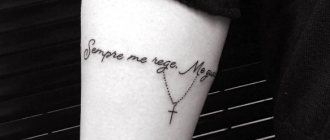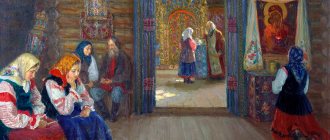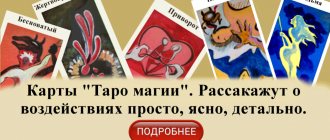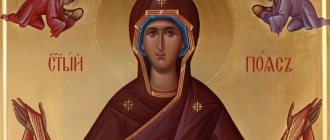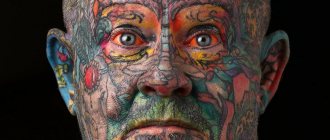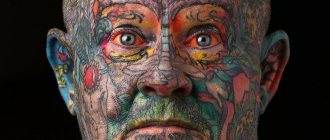Website of the Gorlovka and Slavic diocese
October 1st is World Tattoo Day. Archpriest Georgy Tsyganov, head of the diocesan department for cooperation with the penitentiary service, rector of the Church of the Holy Righteous John of Kronstadt in the city of Kirovskoe, speaks about whether it is possible to participate in the sacraments of the Church with tattoos and whether there are Orthodox tattoos.
Tattoo as a ritual
The Church has a somewhat negative attitude towards tattoos. Tattoos have been known since ancient times. It is believed that the first tattoo appeared by accident. Some person had a wound, dirt got in there and stayed there. Almost all miners who work underground now have such “tattoos”. Coal dust gets into the cuts and marks remain.
In ancient times, tattoos had different meanings. Firstly, informational: seeing a certain tattoo, a person understood what clan, tribe his interlocutor was from, what status he was in. The second meaning was mystical: a person tried to use it as an amulet, thinking that this particular tattoo would protect him from some diseases. The third meaning was ritual, magical: these are tattoos that priests and leaders gave themselves.
In the Old Testament we find a ban on the use of such tattoos. Leviticus says: “For the sake of the dead, do not make any cuts in your flesh or write marks on yourself. I am the Lord (your God)” (Lev. 19:28). The Book of Deuteronomy also prohibits them: “You are the sons of the Lord your God; You shall not make any cuts [on your body] or cut off the hair above your eyes for the dead” (Deut. 14:1). That is, pagan tribes had such rituals in memory of the dead. The Pentateuch of Moses explicitly prohibits this so that the Jewish people do not follow barbaric traditions that lead to ritual murders and other abominations.
Man's violation of God's plan
God created many animals with patterns on their bodies: butterflies, birds. But for animals, such drawings are a natural decoration and a way of protection from the dangers of the surrounding reality. But humans do not need such artificial “additions”. The most skillful Creator, Artist, Sculptor in the world - God, creating man in His image and likeness, did not decorate the body with paints. Therefore, the ideal human appearance is the absence of tattoos. And there is no need to interfere with God’s plan. This always leads to unpredictable and dangerous consequences.
“Man is the image and likeness of God; the Lord initially created him as a beautiful, self-sufficient organism. Therefore, unnecessarily “modifying” your body is, of course, a questionable practice. It’s as if we don’t trust God and are building a personal Tower of Babel in pride, trying to correct the Creator” (Priest Pavel Markovsky).
Tattoos in Rus'
Today in our country tattoos are associated with the criminal world. Historically in Rus' it so happened that ordinary people did not make them. Tattoos were common in Europe among sailors. Going to sea, they engraved crosses and icons on themselves, thinking that this would be their amulet. In our country, tattoos were not common until the end of the 19th century. In tsarist times they were filled with serfs and convicts. Certain symbols meant that a person was in hard labor. In the event of an escape, he could be identified in this way.
Only in Soviet times did the culture of tattoos begin to spread in criminal circles. In the 1990s, when Soviet power faded into oblivion, the criminal world changed a lot. “Thieves in law” ceased to have the power that they had. And now tattoos no longer carry a certain connotation. People began to stuff them to stand out, to show their freedom to their parents or society. Ordinary pride, the desire to be different from others in some way, when there are no personal merits.
Maori leader Tuturei Kareva, late 19th - early 20th century
How to choose a tattoo design for a location on the body?
If the location on the body is predetermined, but the sketch options are still in development, you can take the principle of proportionality as a basis. What is he talking about:
- complex large drawings, entire compositions consisting of different characters of objects, symbols and inscriptions, for example, faces of saints and icons, the crucified Christ, scenes from the Bible, will look harmonious on the chest, back, sides ;
- on the shoulder, forearm, legs and shoulder blades it is better to place tattoos of medium complexity and size, for example crosses, hands of a praying person, prayers, angels;
- small and simple images, amulets, symbols and talismans, for example, crosses, words from prayers, wings, will fit on the hand, wrist, palm, neck .
Facts about tattooing:
- In ancient Japan, a person with a tattoo was persona non grata: he was expelled from his family and society, doomed to complete isolation. On the body of criminals, tattoos were usually made in a visible place and could even tell in which prison they served their sentence.
- In the Japanese province of Chukuzen during the Edo period (1603-1867), as punishment for the first crime, robbers were given a horizontal line across the forehead, for the second - an arched line, and for the third - another one. The result was a composition that made up the hieroglyph INU - “dog”. To this day, a person who has a drawing on his body is prohibited from working in a government agency or swimming in public places.
- In ancient China, one of the five classical punishments was also a tattoo on the face. Slaves and prisoners of war were also marked, making it difficult for them to escape. To this day, in prisons around the world there is a complex system of prison tattoos that imprint on a person the history of his crimes and serving sentences for life.
- The ancient Greeks and Romans also used tattoos for similar purposes, marking slaves. The practice was revived by Spanish conquistadors in Mexico and Nicaragua.
- Mayan women tattooed their faces, which was considered a sign of low origin.
- The word "tattoo" is a borrowing from Polynesian languages. This is what the wild tribes who lived on the islands of Polynesia called tattoos on the body. This method of “decoration” was first scientifically described during his trip around the world by the English navigator James Cook in 1773. He used a word from the Aboriginal language, since there was no such concept in European languages.
- From his trip, James Cook brought not only notes, but also “The Great Omai” - a Polynesian completely covered in tattoos. The appearance of such a miracle caused a sensation in European cities. Not a single self-respecting performance, fair or traveling circus could do without the participation of a “noble savage”.
- It was from traveling circuses that the fashion for tattooing spread to the masses. Since it was not always possible to get natives, the circus performers themselves painted themselves with tattoos. So, at the beginning of the 19th century, a certain Lady Viola flaunted portraits of six American presidents, Charlie Chaplin and many other celebrities, causing the delight of the crowd and making money from it. In parallel, in the same 19th century, artel workers began to apply pigment marks to their bodies to designate their brotherhood, and sailors began to apply pigment marks to their bodies in memory of their travels.
- During the First World War in Great Britain, the “D” tattoo was used to mark deserters.
- Tattooing was practiced in SS divisions. The main theme in the tattoos of soldiers of the Third Reich was Nazi symbols. After the surrender of Nazi Germany, the Allies easily caught the SS men using external inspection.
- Islam prohibits absolutely any tattoos, even those with religious content.
- In Ancient Israel, tattooing as part of one of the pagan rituals was directly prohibited by one of the commandments: “For the sake of the deceased, do not make cuts on your body and do not prick letters on yourself. I am the Lord (your God)” (Lev. 19:28, also Deut. 14:1). This biblical injunction is still followed by Jews and Christians today.
Tattoo and the inner spiritual world
The form is meaningful, and the content is formalized. Not only tattoos, but even clothing can determine behavior. For example, in Russia and many other countries of the world it is mandatory for a judge to wear a robe. This conveys a feeling of solemnity and dignity of what is happening, which is experienced by both the judges themselves and those present. The same can be said about priests in vestments, and police officers, etc.
Discussing further about the form and content in this context, it becomes clear that applying a tattoo to the body is every time a transition from internal work on oneself to external decoration, understood in a unique way. Often this is a sign of internal weakness: a person has no other means to raise his importance. God gave man the opportunity to create. This is a need, but in this case it takes distorted forms. If you look closely, all tattooed people have in their eyes an inexpressible longing for the heavenly and eternal, self-doubt, and spiritual emptiness. Mikhail Krug captured this very subtly in one of his songs, putting the following words into the prisoner’s mouth:
“Kolschik, prick me with domes, Nearby there is a miraculous cross with icons, So that the bells can play there With shimmers and chimes.”
In this regard, we also remember our churches desecrated in Soviet times, with drawings and inscriptions also expressing some form of prayer. Poor, sinful, but still unconsciously aimed at connecting with the Eternal.
I once had the opportunity to communicate with a man who has his own tattoo parlor in Moscow. He said that he often acts as a psychologist when people come to him who have not found themselves, who do not know what they need, who have not even decided what drawing to apply to themselves. He even dissuaded some. For example, teenagers who want to put tattoos on their faces to spite everyone. “You don’t like the way I am, let’s see what it’s like to see me like this!”
Obviously, in such a situation it is not enough to simply declare a tattoo a sin; justification is needed. You need to give a helping hand, and for this it is important to give something more in return.
First of all, let us point out that man is God’s creation. God created everything “very well” (Gen. 1:31). Therefore, making changes to the body, including tattoos, is a rebellion against God. There is such an episode in the life of Saint Peter of Galatia. A woman adorned with rouge and white comes to him for healing.
“What would you say,” the elder said to her, “if you saw a painter who spoils the creation of a great artist: he begins to whiten the face drawn by his inspiration, pour paint, blacken eyebrows and eyelashes?”
The woman fell to her knees and began to ask for forgiveness with tears.
“Remember, my daughter,” he continued, “that if such amendments are offensive for an artist, then even more so for the All-Wise Creator, who so wonderfully adorned man, “making him less than the angels” (Ps. 8:6), for the Great Artist Who gave you your beauty.
The objective criterion of morality for a Christian is the Holy Scripture - the revelation of God to man. If we turn to it, we will find that it condemns not only tattoos, but even immodest clothing and excessive use of cosmetics. God, through the mouth of the prophet Isaiah, threatens the following punishments for these sins:
“And it will happen: instead of incense there is a stench, and instead of a belt you will gird yourself with a rope, and instead of a golden ornament on your head you will have a bald spot for your deeds, instead of a scarlet robe you will put on sackcloth. And your most beautiful son, whom you love, will fall by the sword...” (Isa. 3:23-24).
This was the case back in Old Testament times. And Christians will face even greater condemnation for such sins. “If even then, before grace and such wisdom, this was condemned,” says St. John Chrysostom, “then what justification can today’s wives have, who are called to heaven and to great deeds, who are obliged to compete with the angels.”
The Church considers the human body to be a shrine and a temple of the Holy Spirit. The Apostle Paul says:
“Do you not know that your body is the temple of the Holy Spirit who dwells in you, which you have from God, and you are not your own? For you were bought at a price. Therefore glorify God both in your body and in your soul, which are God’s” (1 Cor. 19-20).
Let us emphasize two fundamental points here. First. We are not ours, we are God’s, our body in the full sense does not belong to us, we cannot do whatever we want with it. Secondly, we can and should glorify God not only in our souls, but also in our bodies. We know that God glorifies the bodies of His chosen saints through the incorruption of their relics and the miracles that flow from them. And these phenomena serve as a kind of destiny, image and symbol of the divine and heavenly glory of the saints, which will be revealed after the general resurrection. It follows that a Christian should take care of his body and treat it with reverence. “For no one ever hated his own flesh, but nourishes and delights in it” (Eph. 5:29).
Further, the human body is sanctified in the Church in the Sacraments of baptism, confirmation, communion, and unction. A Christian in baptism “puts on Christ” (Gal. 3:27) and in everything should strive to follow “His steps” (1 Pet. 2:21). And just as we cannot put inappropriate inscriptions on sacred vessels, so it is unacceptable to do this on our bodies. This sanctification of human flesh is based on the great mystery of the Divine Incarnation, death, resurrection and ascension of Christ. The Lord took flesh, made it His own and deified it, according to the word of the Gospel: “And the Word became flesh and dwelt among us, full of grace and truth” (John 1:14). With the assumed flesh, Christ ascended into heaven “and sat down at the right hand of God” (Mark 16:19). And since our Lord Jesus Christ became a perfect man in soul and body, similar to us in everything except sin, then He gives us, who believe in Him, from His Divinity and makes us akin to Himself in the nature and essence of His Divinity. And should we, Christians, who have such gifts and promises, who look forward to the resurrection of the dead, defile our flesh with inscriptions and images?
Why is the Church against tattoos?
Nowadays, people get tattoos with the faces of Christ and the Virgin Mary. People who are not involved in the criminal world think that this will be some kind of talisman for them. The Church has a negative attitude towards this. The Lord created man perfect. Trying to supplement this perfection with something, we take on the mission of God - we try to show that we know Him better and can do more. Basically, those who get tattoos have a desire to show themselves and distinguish themselves.
Coptic girl with a cross tattoo on her wrist. Photo: B. Armange / Associated Press
Orthodox tattoos - what are they?
In some countries of the world, persecution of Christians continues today. Moreover, these persecutions threaten believers not just with discrimination in some rights, but often with death. Therefore, believers have to fill crosses on their hands so that brothers in faith can bury them in a Christian manner in case of sudden death. Such Orthodox tattoos express love for Jesus Christ. Man, despite the danger, follows the Savior and is ready for His sake to undergo martyrdom at the hands of Gentiles.
Only in such circumstances can tattoos be considered appropriate and justified from the point of view of Orthodoxy. For example, in the modern world, Coptic Christians in Egypt get small cross tattoos on their wrists. This is a symbol of their faith and visible evidence that they are not Muslims.
Read us conveniently on social networks:
Tags: attitude of the church to tattoos, Orthodox tattoos, Orthodox tattoos, tattoo is a sin, Christian tattoos
Are tattoos in the form of a cross or icon allowed?
Christians in the East have a tradition of tattoos. In Africa and the Middle East, Christians tattoo small crosses on their hands. They live in constant danger. The Muslim world is very aggressive towards Christians. By putting this sign of the cross on themselves, Christians show the firmness of their faith, their readiness to go with Christ even to death. In case of death, this sign will help ensure that they are buried in a Christian manner.
This differs from our Zonov traditions of embossing crosses all over the back - there is a small cross, which is hidden somewhere under the clothes, like our pectoral cross. People around us don’t see it unless we specifically show it off. At the same time, we know that this symbol of our faith is always with us.
In the 12th century, the Arab conquerors who invaded Egypt began to forcibly convert Christians to their religion. One form of resistance to this was that Coptic Christians began to tattoo themselves on the inside of their right wrists - an image of a cross. Since Islam explicitly prohibits tattoos, and the impaled image of a cross cannot be removed, forced conversion to Islam for Copts has become impossible.
Many centuries have passed, but tensions between Christians and Muslims in the East have not disappeared. Christians still impale a cross on their hands, thereby expressing their readiness to accept martyrdom for Christ and refusal to convert to Islam.
We will be held accountable for all our actions. I have met a lot of people who, especially in the army, made such tattoos for themselves. Then, when they came to faith, they were embarrassed by this tattoo and did not want the people around them to see it. Taking her out is a very painful process, few people have gone through with it. I would advise a person who is just coming to God and wants to get a tattoo to think about how much he needs it. We can remove any bracelet or medallion. Today I like him, but tomorrow I don’t. A person will not be able to remove the tattoo. Burning it out is very painful.
"Fashionable" fad
Every year, especially in the summer, we notice how many people, especially young people, have fashionable “accessories” in the form of tattoos on their bodies. The number of tattoo parlors in cities is becoming comparable to the number of cafes. People give each other certificates to visit these salons. The majority of visitors there are, of course, young people. If tattoos used to be an element of the prison or, less commonly, army subculture, today it has become a fashionable and common occurrence. It happens that parents themselves bring their teenagers to tattoo parlors. Although in general it is difficult to imagine parents who want to “decorate” their children in this way. In Spain, I remember the advertising stand of a tattoo parlor. A baby is depicted in a diaper, painted from head to toe. And at the top there is the inscription: “Mom, I’m sorry!” The older generation looks at the growing popularity of tattoos with bewilderment and horror. Many still remember that tattoos were applied forcibly in German concentration camps. But there are also fathers and mothers who want to keep up with the times. There is a known case when a pensioner, at the age of 65, put a tattoo on his body for the first time.
This phenomenon also penetrates into the church environment. Either people come to God already having tattoos, or Christians, out of ignorance, succumbing to the spirit of the times, apply images and inscriptions to their bodies. There is a whole tattoo industry operating at the resorts. Moreover, it is designed for children too: henna designs are applied to them, and they are washable. But the message is hidden in the mind that “tattoos are cool and stylish, when you grow up, you will do everything like an adult.” Tattoos are especially common in Europe. Apparently, the widespread nature of this phenomenon in the West prompted the Old Believer metropolis in Romania to discuss this topic in 2022 and make a special conciliar decision. Let's remind him:
“Consider tattooing the body a sin that does not prohibit baptism. Call on the children of the Church and especially the younger generation to abstain from this vice” (paragraph 4 “On the possibility of accepting into the bosom of Christ’s Church people who have a written off body (tattoos)”).
This, by the way, is the only official opinion of the Church on this matter. As far as I know, not a single local church has expressed its position on this issue. We do not know the reasoning part of the decision of the Belokrinitsky Metropolis, so we will try to figure out on our own what served as the basis for such a conclusion.
Orthodox symbols in criminal culture
It is necessary to take into account the specifics of tattoos in our culture. In the criminal world there is also a tradition of stuffing crosses and icons. This tradition has its own subtext. Today a person does not always know what his tattoo means, what meaning it carries. And he may find himself in a situation where he is told something about his tattoo that he does not know.
So, the image of domes dates back to the 1930s. Domes mean that the person was sitting. Their number shows how many walkers he had per zone. It happens that there is only one dome, but several windows are depicted on the drum. In this case, the number of walkers shows their number. Crosses, if they are pinned on the hands, also indicate the number of walks.
The crosses on the domes also have their own meaning. If the dome has a cross, this means that the prisoner served in prison from bell to bell - from the moment he was imprisoned until the last day of his sentence, without parole, which is given for good behavior. If the window on the dome is dark, this means that the person was in a punishment cell - a solitary cell. For people who have never been to prison, these images mean nothing. And for prisoners, this means that a person is going to openly protest against the authorities, and for this resistance he ended up in a punishment cell. Accordingly, the authority of this person in certain thieves' circles increases.
Icons of Christ are usually knocked out by convicts as a talisman. This often happens when a prisoner is just beginning to come to faith. He begins to think about spiritual issues. With such a tattoo he shows his repentance. This is the beginning of his path to God. This path does not necessarily end with churching. Such a tattoo may mean that a person came to faith in prison.
Any operational police officer must undergo training in recognizing tattoos. Previously, in the world of thieves, the tradition of tattooing rings on fingers and the like, which were put on display, was very widespread, because you couldn’t hide your hands. Often the number of walks was marked with crosses on the fingers. But sometimes they are pricked as a talisman.
Tattoos of icons of the Mother of God also have ambiguous meaning. They are made by convicts as a talisman; they can be a sign of a person’s repentance. The subtext of such an image, which dates back to Soviet times, is that a person at a young age embarked on the path of thieves. A person needs to think about what this or that tattoo conveys besides the meaning that he wants to put into it.
There have been cases when someone, having decided to show off to friends, behaved impudently, got tattoos for himself, then went to prison for hooliganism, and there he was told that he did not have the right to wear certain tattoos - he had not yet reached such a “level” in criminal world. And such a person was punished in prison by his fellow inmates: his tattoos were burned out.
Cancerous growth at the site of the tattoo
The best places to place an Orthodox tattoo
When choosing a place to place a Christian tattoo, you need to take into account the fact that it may be perceived differently by people around you. Historically, it has been desirable to place certain body designs on specific parts of the body. For the most part, this is due to the meaning of the tattoo.
If it carried a deep meaning, it was placed in more visible or significant places. If a tattoo described the character of its wearer, it was placed in places that were not accessible to everyone. The most popular places where women's and men's religious tattoos are tattooed:
- Shoulder – most often, tattoos depicting the hands of a praying person are located on the shoulder. This emphasizes strength and courage. Sometimes saints are tattooed on the shoulder, like Jesus;
- Forearm - mainly the gates of heaven, the faces of saints, and Jesus Christ are impaled on the hand. The drawing in this place denotes strength of spirit, craving for God;
- The wrist is an ideal design for this part of the body - a small Christian attribute. Mostly, doves, anchors, roses, and lambs are stuffed on the wrist. Less often - crosses;
- Palm and hand – religious symbols are often printed on the edge of the palm. Sometimes excerpts from religious scriptures are placed on the palms;
- Neck – most often crosses, Orthodox attributes, and inscriptions are printed on the neck;
- Chest – large tattoos are placed on the chest. These are mainly inscriptions, wings, tattoo icons. It is believed that the design on the chest is a strong talisman for a person.
- Side - crosses, angels, saints are stuffed on the sides. A tattoo on the side can denote religious and ethnic affiliation;
- Thigh - Orthodox tattoos are prohibited in this place, as it is believed that they carry an intimate meaning;
- Back – the most popular back tattoos are angel wings. Church domes and faces of saints are not uncommon. Such a tattoo symbolizes the burden that a person carries;
- Shoulder blade – symbols and text are mostly printed on the shoulder blade;
- Leg – Orthodox tattoos on the leg are decorative;
- Sleeve tattoo - this type of Christian tattoo image is very popular. Almost all types of Orthodox tattoos are placed on it.
The danger of a tattoo is something that is usually hushed up or downplayed by tattoo parlors
Poison under the skin
The red ink used for tattoos contains mercury sulfide, while other shades contain titanium, chromium, lead and cadmium. Blue paint is considered the most dangerous. It contains cobalt and aluminum. No less dangerous poisons are paraphenylenediamine and arsenic, which are part of black ink. The last component can easily cause cancer, and all the others poison the body and lead to damage to muscle tissue. The pigments used in tattoo parlors are not regulated by health authorities.
Death at the end of the needle
Thousands of people have become infected with HIV, hepatitis B and C using a tattoo needle. Many viruses are not killed by boiling or other types of sterilization.
Cancer that might not have existed
It is caused not only by arsenic, which is part of the paint. Many people try to hide moles and other skin defects with tattoos. Meanwhile, doing this is strictly prohibited. In principle, not only a mole, but also any tattoo under the influence of ultraviolet sunlight can cause skin cancer.
According to a study conducted in Europe, one third of clients of salons and private artists faced negative consequences of tattoos.
Scars
A tattoo cannot be removed without a trace. Even with laser removal, scars remain. When removed by other means, the size of the scars will be larger than the size of the tattoo being removed due to the destruction of the skin. In fact, to remove a tattoo means to lose a fragment of your own skin.
Tattoo amulets for women who are not advisable to get tattooed
Women should not print the following images:
- Children's names. From the outside it looks like the lady is afraid to forget them.
- Butterfly. A symbol of a representative of the oldest profession.
- Skulls for tattoos are only allowed for those girls who have gone through serious trials in life.
- Nazi symbols. In Russia, you can earn a fine for such tattoos.
- Portraits of loved ones. It is almost impossible to make an image of good quality: familiar features will be difficult to discern in the drawing.
Women's tattoos are distinguished by their unique charm and energy. When choosing a design, you need to be guided by three main points: style, place of application and esoteric overtones.
Is it possible to participate in the sacraments of the Church with tattoos?
A tattoo can neither bring a person closer to God nor alienate him from Him. There are no obstacles to participating in the sacraments. In the prisons where I look after, there are a lot of people with tattoos. They have them, and nothing can be done about it. They won't understand why tattoos are condemned. It happens the other way around - the condemned person stuffs an icon of the Savior or the Mother of God as a sign that he has taken the path of correction. Perhaps this tattoo will even help him in some way.
If a person has never entered the zone, but has a tattoo, it would not be superfluous to say in confession that in his youth he had a desire to stand out, and he got a tattoo. Often this is one of the manifestations of pride, and confession will help the priest find the right approach to the person.
Is it a sin to get a tattoo?
Are tattoos a sin? It would be more accurate to say that tattoos in some cases are the result of sinful passions. Tattoos are done in order to stand out from the crowd, to show that “I am special, not like everyone else,” “I am not a gray mass.” And instead of harmoniously developing one’s inner world, intellect, and engaging in spiritual development, a person strives to prove himself only with a bright appearance. Including all kinds of tattoos. The manifestation of such narcissism is increasingly affecting the younger generation. Subsequently, vanity (the need to confirm one's superiority) inevitably leads to many other sins.
One of the most dangerous reasons for getting a tattoo is the occult and magical activities. Pagan shamans and priests tattoo various images and writings on their bodies to attract spirits and otherworldly forces. In Orthodoxy, such “entities from another reality” are called demons, evil spirits. Therefore, Orthodox tattoos in everyday life are nonsense.
Psychologist Victor Larkin: “The essence of occult-magical motives and methods of tattooing is to purposefully attract dark forces into your life. And this is no longer just spontaneous pride or the whim of over-aged teenagers, this is the direct merging of a person with evil. It can be unconscious when a person is not told anything about what and how tattoos are applied to him. And it can be conscious when a person himself, by his own will, puts himself at the disposal of dark forces. If a person consciously accepts the occult-magical nature of a tattoo, then the degree of their destructive influence increases. It increases even more if combined with alcohol, drugs, beer and psychedelic stupor in discos and computer games. At first they cause adrenaline, courage and bravado, self-esteem, “authority” and “respect” are inflated, but then an inevitable reckoning occurs: the loss of both physical and spiritual health. Moreover, the disastrous consequences of a tattoo can only appear after many, many years” (from a conversation on Radio Radonezh).
Can a person with a tattoo be a priest?
Yes maybe. We even have an example of a tattooed priest - Ivan Okhlobystin. But a tattoo can complicate life in the future. Our people have a very strong belief that if a person has tattoos, it means he belongs to the criminal world. For a priest, if he has a tattoo in some open place, this can greatly interfere with his communication with people. Some will be indifferent, but many are alarmed.
A priest is usually looked at as some kind of ideal person in whom everything should be perfect. People often don’t want to take into account that he is the same person as the rest, so a priest with tattoos can face various troubles. Although this will not distance him from God in any way.
Interviewed by Maria Tsirlina
Website of the Gorlovka and Slavic diocese
Popular religious symbols and their meanings
Popular Orthodox symbols include the following:
- the Latin cross is a symbol of Christianity (Orthodoxy), bestows good luck and protection from evil;
- the lamb is a symbol of Christ, sacrifice and non-resistance;
- anchor - the memory of the dead, and in general a memorable event;
- rose - a symbol of the Mother of Christ, mystery, purity, martyrdom;
- dove – freedom of the soul, gives hope, symbol of the Holy Spirit;
- Jerusalem cross - a symbol of the Crusades, contains 5 crosses;
- the baptismal cross is a symbol of rebirth, immortality of the soul;
- Peter's cross is a symbol of respect for Christ, often used by Satanists as a symbol of opposition to religion.
Orthodox tattoo on shoulder
Slavic tattoos of animals and birds
Quite often, animals or birds were the main focus of the tattoo. They all have completely different meanings, which are worth knowing before the application process. For example, the bear is the owner of the forest and the embodiment of the god Veles. Therefore, a symbol in the form of a tattoo always means power, strength, as well as health and fertility.
The wolf is the guide of souls to the afterlife. Often such a symbol means justice, courage, cunning and even loneliness. However, when choosing this option for yourself, try to put into the drawing the correct message that suits you personally. Otherwise, the amulet will only do harm.
In turn, the raven has always been associated with dark forces. Despite this, he is a wise bird. It is most often chosen by men. The image of a dragon symbolizes the unity of life and death, as well as good and evil. Many believe that such a talisman helps to avoid or overcome internal disagreements that are characteristic of every person.
If you decide to get a Slavic tattoo, be sure to look for an experienced artist. The fact is that in this case every detail matters. Therefore, it is very important that he is familiar with the specifics of applying such drawings.
Slavic runes: meaning of tattoo
Not many people know that Slavic runes are a manifestation of writing. They have a deep historical meaning. Of course, it takes quite a lot of time to understand the meaning of each of them. However, in general, we can say that each symbol looks unusual in its own way. Their interpretations contain words such as rainbow, peace, strength, support, rock and much more.
